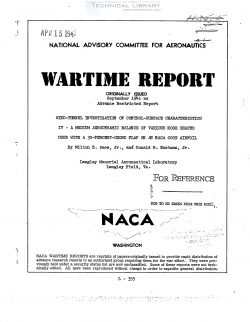naca-wr-l-355
- Version
- 147 Downloads
- 1.32 MB File Size
- 1 File Count
- April 3, 2017 Create Date
- April 3, 2017 Last Updated
Wind Tunnel Investigation of Control Surface Characteristics - IV - A Medium Aerodynamic Balance of Various Nose Shapes Used with a 30% Chord Flap on an NACA 0009 Airfoil

Tests have been made in the NACA 4— by 6-foot vertical
wind tunnel of an EACA 0009 airfoil with a 30—percent-chord
flap having a medium amount of aerodynamic overhanging ba1~
ance. In the investigation the effects of the shape of the
flap—nose overhang and the gap at the nose of the flap have
been determined. A few tests were made to determine the
effectiveness of a tab on the balanced surface° The aero-
dynamic section characteristics of the various arrangements
tested are given. A partial analysis of the data has been
made, and the results discussed.
The results indicate that, in general, the lift effec~
tiveness of the aerodynamically balanced flap was increased
slightly over that of a plain flap when a blunt or medium
flap nose was used on the balanced flap. The balance effec-
tiveness of the flap having the medium amount of aerodynamic
balance showed an appreciable increase over that of a flap
having a small aerodynamic balance. The flap with the
blunt nose shape proved to be the most effective in reduc-
ing flap hinge moments. The adverse effect of an unsealed
gap on the balance effectiveness of the flap with a medium
amount of aerodynamic overhang appeared to be of smaller
magnitude than for a plain flap or a flap having a small
aerodynamic overhang. The medium nose on the flap gave the
highest values of lift at positive angles of attack and
flap deflection with the largest gap tested. The effective-
ness of a tab as a balancing device for a flap having a
medium amount of aerodynamic overhang was slightly less
than for a plain flap. The minimum profile~drag coefficient
of the airfoil with the most tapered nose shape was 0.0024
greater than for the airfoil with the blunt nose flap,j
while the medium nose flap on the airfoil resulted in an
increase of 0.0014 in profile~drag coefficient over that
for the airfoil with the blunt nose flapo
INTRODUCTION
The problem of reducing the hinge moments on the con—
trols of an airplane is becoming more acutewith the in-
creases of speed and size of modern airplanes. To cope
with this problem the NACA has in progress an extensive
investigation of the aerodynamic characteristics of con-
trol surfaces. The investigation has as its purpose the
presentation of design data for the determination of the
types of flap arrangement suitable for use as control sur—
faces. Because a conventional control surface is merely
a flap on an airfoil, these two terms are used synonymously
in this paper. ‘
As part of this investigation, the effects of flap-
nose shape, flap~nose gap. and balance on a typical hori-
zontal tail of finite span were determined in the full»
scale wind tunnel. (See reference 1.) The more detailed
part of the investigation is, however; being made in two~
dimensional flow.
The first part of the two-dimensional flow investi~
gation was the determination of the section characteris-
tics of airfoil-flap combinations with plain flaps of’
various sizes and with sealed gaps. (See references 2,
3, and 4.) The data presented in references 2, 3, and
4 have been analyzed, and parameters for determining the
characteristics of a thin symmetrical airfoil with a plain
flap of any chord and a sealed gap at the flap nose are
given in reference 5. The results of force tests of a
plain flap with various gaps at the flap nose are reported
in reference 6. Tests to determine the effect of flap-
nose shape on a EOopercent-chord flap having a 20-percent~
flap—chord overhanging balance with various gaps at the
flap nose were conducted in the HAGA 4— by 6-foot wind
tunnel, and the results are presented in reference 7.
The present investigation consisted of tests of an
airfoil having a 30-percsnt-chord flap with a 55~percent~
flap-chord overhanging balance of several nose shapes and
with various amounts of gap at the flap nose. To expedite
tie publication of the data, only a very limited analysis
: the results has been made.
| File | Action |
|---|---|
| naca-wr-l-355 Wind Tunnel Investigation of Control Surface Characteristics - IV - A Medium Aerodynamic Balance of.pdf | Download |

Comment On This Post